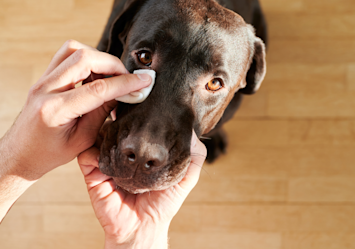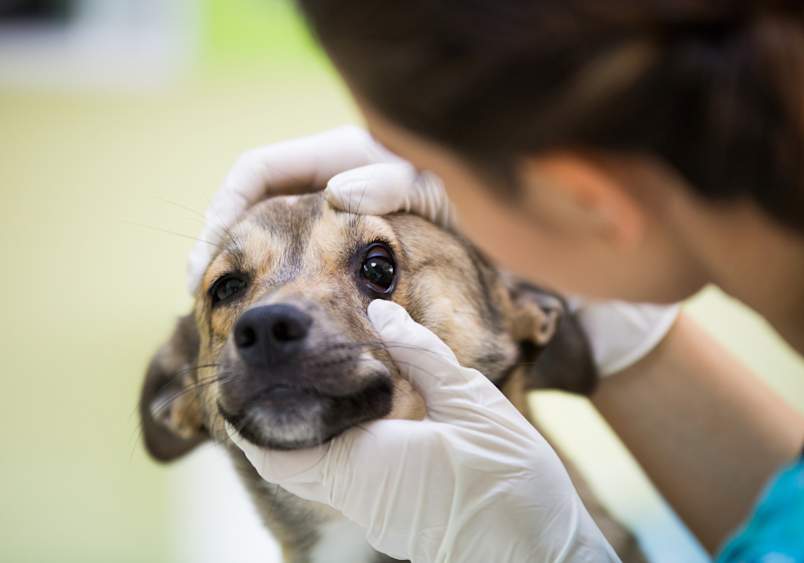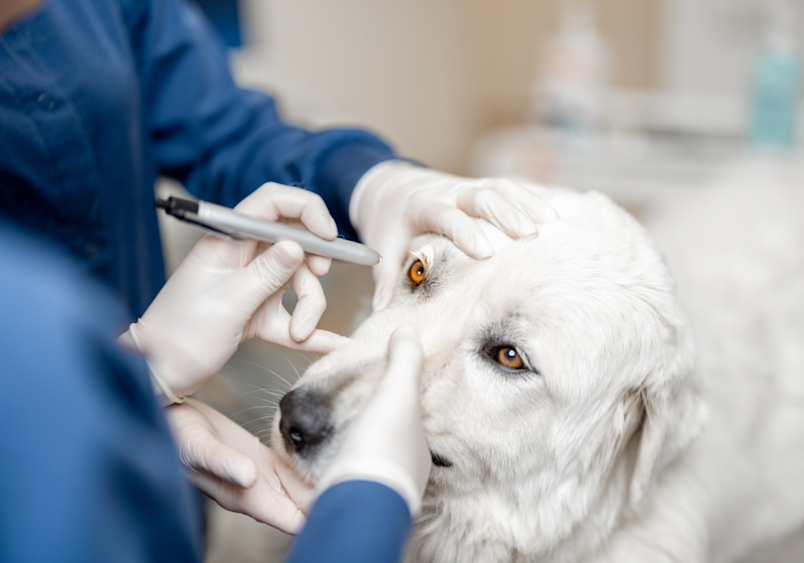
Have you ever gazed into your furry friend's eyes and noticed something unusual? A small dark speck or a brownish dot where there was not one before? As a concerned pet parent, such discoveries can be alarming. But don’t panic just yet! These mysterious black spots on dogs’ eyes can vary from harmless freckles to a signal of a more serious condition.
A Personal Experience of Black Spot on My Dog's Eye
I learned the value of checking my dogs' eyes on a regular basis on July 12, 2018 when I saw a small black spot on the iris of Hero, my youngest dog's left eye. It was different enough that I took a photo of it. I was questioning myself, "Had it always been there?" Had I missed it previously?" But I continued to watch it and, unfortunately, it grew larger. Just a few weeks later, I took Hero to our regular veterinarian who recommended we see an eye specialist. On September 21, 2018, the melanoma on his iris was removed. A year later, he is doing well with full vision in his eye.
That experience taught me the importance of documenting and promptly addressing any changes in my pet’s eyes, because that helped in both the diagnosis and treatment.
Common Causes of Black Spots in Dogs' Eyes
Black spots in a dog's eye can be indicative of various underlying issues, each with different implications for your pet's health. Understanding these causes is vital for timely and effective treatment. The potential causes include:
Iris Freckles: These are small, benign pigmented spots that appear on the iris, much like freckles on human skin. They are usually harmless and do not affect your dog's vision.
Iris Melanoma: This is a more serious condition where a dark spot on the iris could indicate a malignant tumor. It requires immediate attention from a veterinary ophthalmologist to determine the extent of the condition and appropriate treatment options.
Uveal Cysts: These are fluid-filled sacs located in the uvea (the middle layer of the eye) that may appear as dark spots. They are generally benign but should be monitored to confirm they do not lead to complications.
Pigmentary Keratitis: This occurs when pigment accumulates on the cornea, often due to chronic irritation or inflammation. Over time, this can affect vision and cause discomfort for your dog.
Corneal Sequestrum: Although more common in cats, dogs can also develop corneal sequestrum. This is a condition where a portion of the cornea (the clear front part of the eye) becomes damaged and dies, resulting in a dark spot. It requires prompt treatment to prevent vision loss and further eye damage.
It is essential to recognize that while some black spots may be benign or harmless, others could signal more serious conditions. So, always consult with your veterinarian if you notice any changes in your dog's eyes.
The Importance of Regular Eye Checks
We look into our dogs' eyes daily. But at least once a day, take a moment not just to admire their eyes, but to carefully examine them. The spot on Hero's eye started out to be smaller than the tip of a lead pencil! Thankfully, I noticed it early on. This is why paying attention to any changes in your dog’s eyes is important.
What to Look for During Eye Checks
Healthy eyes should be clear and bright with a wet look to them. The iris can be all one color, streaked with a second color, or marbled (multi-color). Look out for any changes in the iris, especially dark or black spots, a distortion in the pupil, or a change in the iris's shape.
The whites of the eyes are not as visible as with our own eyes and vary from one dog to another and in different breeds. You should personally know what is normal for your dog and what is not. Look at the color that you can see; it should ideally be white. Healthy eyes look alive and should move when you track motion. After all, the eyes are the windows to the soul, as literature always tells us.

Symptoms Associated with Black Spots in Dogs' Eyes
Black spots themselves may not always cause noticeable symptoms, but they can sometimes be associated with other signs that warrant attention. Look out for:
Changes in Eye Color or Appearance: Any alteration in the color or overall look of the eye may indicate a problem.
Squinting or Excessive Blinking: Your dog may squint or blink more than usual if they are experiencing discomfort or vision issues.
Rubbing at the Eye: Persistent rubbing or scratching of the eye can be a sign of irritation or pain.
Visible Swelling or Redness: Swelling or redness around the eye may indicate inflammation or infection.
Changes in Pupil Size or Shape: Any abnormal changes in the size or shape of the pupil can be a cause for concern.
Cloudy Appearance in the Eye: A cloudy or hazy appearance could suggest a serious underlying condition affecting the cornea or lens.
Noticeable Vision Changes: Difficulty seeing or navigating could signal significant eye issues impacting your dog's vision.
If you notice these symptoms, with or without black spots, please seek veterinary care as soon as you can to address any potential issues.
Understanding Eye Discharge and Eye Inflammation
Attentively check for any changes in your dog's eyes. It's normal for healthy eyes to have a tiny bit of discharge, especially when your pup wakes up from a nap or comes inside after exercise. Yet, some dog breeds are prone to producing more tears than others. The Pugs, Bulldogs, Shih Tzus, Poodles, and Boxers tend to produce more tears and, as a result, have more eye discharge. While excessive tearing is common in brachycephalic breeds like Pugs, it's worth noting that these adorable flat-faced dogs can face more severe eye issues. In fact, pug eye problems can range from minor irritations to more serious conditions that require immediate veterinary attention.
Tears help keep the eyes clean, so a bit of discharge is normal. However, a heavier or different discharge can be a symptom of a problem. Watery eyes, thick mucus discharge, or even yellow or green pus-type discharge is usually a sign of conjunctivitis; an inflammation of the lining of the eye. This can be caused by many things, from an injury to allergies or tear duct problems. Excessive tearing can also result from eyelashes rubbing against the eye, a dog rubbing their eye, injuries, foreign substances, or other eye illnesses.
Recognizing Eye Inflammation with Red, Swollen Eyes
Any redness, swelling, or discharge in your dog’s eyes is cause for concern. If both eyes are pink and irritated, especially with clear discharge, allergies might be the culprit. However, if redness, swelling, and abnormal discharge are present, the issue could be more serious, ranging from minor irritations like eyelashes rubbing the eye to infections (bacterial, viral, or conjunctivitis). If only one eye is affected, an injury, such as a scratch from play or outdoor activities, may be the cause.
Diagnosis and Treatment of Black Spots in Dogs' Eyes
If you notice a black spot on your dog's eye, a thorough veterinary evaluation is essential to determine its cause and appropriate treatment. The diagnostic process may involve:
A Thorough Eye Examination: The veterinarian will inspect the eye closely to assess the nature and extent of the black spot.
Tonometry: This test measures eye pressure to check for conditions like glaucoma that might be related to the black spot.
Ophthalmoscopy: An examination of the interior of the eye to identify any internal issues.
Imaging Tests: X-rays or ultrasounds may be used to visualize deeper structures within the eye.
Biopsy: In some cases, a biopsy might be necessary to determine if the black spot is malignant.
Treatment Options Will Depend on the Underlying Cause and May Include:
Monitoring: For benign conditions, regular check-ups may be sufficient to make sure no changes occur.
Medications: Prescribed for infections, inflammation, or other treatable conditions.
Laser Surgery: Used for certain growths or tumors that need to be removed.
Surgical Removal: For tumors or other significant issues that require direct intervention.
Cryotherapy or Radiation: Used in more severe cases, such as malignant tumors that need aggressive treatment.
Your veterinarian will guide you on the most suitable treatment plan based on your dog’s specific condition and its severity.

When to Worry About a Brown Spot on Dog's Eye
Brown spots on a dog's eye can range from benign freckles to more serious conditions like melanomas. Here are some guidelines to help you determine when to be concerned:
Size Changes: If the spot is growing or changing shape rapidly, it could indicate an underlying problem that needs evaluation.
Multiple Spots: The sudden appearance of several new spots might suggest a more systemic issue or condition that requires further investigation.
Raised Spots: Spots that become raised or textured could be indicative of a more serious condition, such as a tumor or cyst.
Associated Symptoms: If your dog shows signs of discomfort, such as pawing in the eye, or exhibits changes in vision, it is important to consult your veterinarian.
Location: Spots located on the sclera (the white part of the eye), or eyelid may be more concerning than those on the iris, as they could indicate different types of issues.
Can Dogs Have Birthmarks on Their Eyes?
Yes, dogs can have birthmarks! Just like humans, dogs can be born with or develop pigmented spots on their skin, including around their eyes. These can appear as dark spots or patches and are usually harmless. However, it is important to monitor any pigmented areas for changes in size, shape, or color, as these could imply a more serious condition.
What are Benign vs. Concerning Spots for a Dog Eye Freckles?
Dog eye freckles, also known as iris freckles or iris nevi, are usually benign pigmented spots on the iris. They are like freckles on human skin and are generally harmless. But these spots should be monitored for any changes, as some may develop into melanomas over time. Regular check-ups with your veterinarian can help catch any concerning changes early.
Understanding Cataracts or Cloudy Eyes
In a healthy eye, the lens covering the center of the eye is crystal clear, allowing light to pass through easily. However, when the lens becomes cloudy or even opaque, it affects the dog's vision. A cloudy lens lets less light through, impairing vision, while an opaque lens can nearly blind the dog.
This cloudiness is known as a cataract, which can be caused by various factors. Some dog breeds are unfortunately more prone to cataracts and might develop them early in life, known as juvenile cataracts. However, cataracts are more commonly seen in older dogs. Additionally, an eye injury can also lead to a cloudy spot on the lens.
The Role of Pet Insurance in Eye Care
Just as we invest in health insurance for ourselves, securing pet insurance for our furry friends can be a game-changer when it comes to eye care. Unexpected eye conditions, from simple infections to more complex issues like melanomas, can arise at any time. With a comprehensive pet insurance plan, you can make sure your dog receives top-notch care without the added stress of financial burden. By investing in dog health insurance you are not just protecting your wallet, but you are safeguarding those soulful eyes that look at you with unconditional love every day.
Keeping an Eye on Your Dog's Eye Health
Your dog's eyes offer valuable clues to their overall health. From mysterious black spots on dogs’ eyes to changes in color, any alteration demands your attention. By familiarizing yourself with common eye problems and their symptoms, you can be a vigilant guardian of your furry friend's vision. Remember, regular eye exams are essential for early detection and maintaining your dog's eye health. If you notice any changes in your dog's eyes, no matter how minor, consult your veterinarian promptly. Early intervention is crucial for preventing discomfort and potential vision loss.
Thankfully, in my case, I got Hero in to see an eye specialist quickly. By having the melanoma removed early, Hero's vision was saved. Had I waited, he could have lost his vision, and even his eye entirely.
Your dog relies on you to be their voice. So, remain observant and educated about trivial things like this, to ensure that those adorable puppy dog eyes continue to light up your life with every wag, every play, and every cuddle. Here’s to many more years of eye-to-eye bonding with your beloved canine companion!